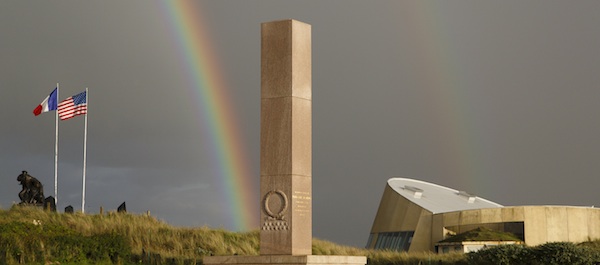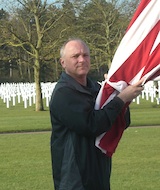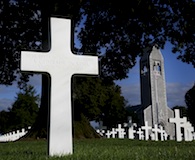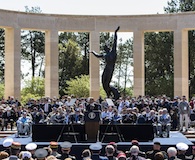
The Utah Beach Memorial, Normandy, France. The American Battle Monuments Commission (ABMC) oversees design, construction and maintenence of American cemeteries and monuments in foreign lands. Warrick Page / ABMC photo
World War I was the first conflict in which American troops served overseas in any significant numbers. For the first time the nation had to deal with tens of thousands of Americans who had died a very long way from home and were interred overseas. Who would watch over them, tend their graves?
On March 4, 1923, the United States government established the American Battle Monuments Commission (ABMC). An agency of the executive branch of government, its mission is “to design, construct, administer and maintain permanent U.S. burial ground in foreign countries; and to control the design and construction on foreign soil of U.S. military memorials, monuments and markers by U.S. citizens and organizations, public and private, and encourage their maintenance.” General of the Armies John J. Pershing was the Commission’s first chairman.
At the present time, ABMC is responsible for maintaining 25 permanent American military burial grounds and 23 separate memorials, monuments and markers on foreign soil, and three memorials in the U.S. The Commission has approximate 400 full-time civilian employees, about 70 of whom are U.S. citizens and the rest foreign nationals from the countries where the ABMC installations are located.
On July 31, 2014, HistoryNet‘s editor, Gerald Swick, spoke with ABMC’s Director of Public Affairs, Tim Nosal, about the organization’s history and future plans.
* * *
HistoryNet: Not all Americans who died overseas are buried there. What determines whether one of the fallen is buried abroad or in the United States?
Tim Nosal: That’s a good question. It was something the US government grappled with at the end of World War I. The major of our conflicts up to that time had been fought in the United States. The great majority of Spanish-American war dead were brought home, not purposely buried overseas. At the end of World War I Congress had to deal with the tremendous logistics problem of bringing the dead home—116,516 Americans died overseas, according to the Department of Defense. Congress realized Americans would want a choice, so notices were sent to families of the war dead. The families could choose permanent internment overseas, with permanent care paid for by the US Government. Or their family member could be interred in a national cemetery in the United States or could be sent home for private, local burial. In the latter case, the family had to pay for the internment, but the government paid to ship the bodies home.
 Few people realize that many of the dead from World War I are buried in their native countries in Europe, such as Poland and Greece. Many immigrants fought for America. Their families had the option to have them buried in their native county, and a number chose to do so.
Few people realize that many of the dead from World War I are buried in their native countries in Europe, such as Poland and Greece. Many immigrants fought for America. Their families had the option to have them buried in their native county, and a number chose to do so.
Finally, there was the least-executed option: burial in place. Some said, “Leave his remains where they are now; don’t disturb them.” The most famous such was the son of former president Theodore Roosevelt, Quentin Roosevelt. He was left buried in place following the war. Following World War II, he was moved to Normandy American Cemetery to rest alongside his brother, Theodore Roosevelt Jr.
The process was a bit more formalized following World War II, but families were offered the same options with regard to our over 450,300 dead from that conflict. My dad’s uncle was killed in the Second World War. The family chose to have him repatriated to Illinois; he’s interred in Rock Island National Cemetery.
HN: About how many families chose internment overseas?
TN: In both wars, about the same percentage of families, 23-30 percent, chose internment overseas. In both wars the great majority chose repatriation to the United States.
This process was very different than the process followed by other nations. With the dead from the British Commonwealth, everyone was buried in the nations where they fell. Given the large numbers of dead the Commonwealth had to deal with, it would have been nearly impossible to repatriate them all.
At request of the government of France, the US and other nations, including Germany, were asked to consolidate their own nation’s cemeteries in France. There were some exceptions: some Americans are buried with Commonwealth forces and vice versa, for example. Likely, they were serving with Commonwealth or French forces during war, such as the Lafayette Escadrille.
American cemeteries were created to honor the American forces. In earlier wars, European dead were buried in mass graves. Following World War I, cemeteries were to have individual graves, but in many European nations it was illegal to exhume the dead; governments had to pass laws to create exceptions or find other ways around that issue.
The American Battle Monuments Commission was created to design and implement these overseas cemeteries so it would be an orderly process. Eight permanent American cemeteries were established: one cemetery in the UK, one in Belgium, and the rest in France.
An interesting aspect of all this is the Commission was very interested in controlling design and placement of individual and divisional memorials. Who was going to take care of those memorials in later years? To avoid embarrassment to the United States, ABMC tried to influence how these monuments were designed, e.g., make them of brick or other materials that would last. Several of ABMC’s World War I monuments in France, like the one at Chateau-Thierry, dwarf the monuments on the National Mall in Washington, D.C. ABMC hired the best architects at the time. Architects like Paul Cret, who designed several memorials on the National Mall, designed may of ABMC’s World War I memorials.
HN: During the wars, men were buried close to where they died. Was the ABMC responsible for transporting remains after the war to the cemeteries it maintains?
 TN: No. We were responsible for the design, construction and layout of cemeteries. The American Graves Registration Service under the U.S. Army’s quartermaster general was responsible for moving remains. Many people don’t realize the US Army today is custodian for all records of war dead, regardless of which branch they served in. The World War I burial records have been moved to the National Archives now, but the Army is still considered the custodian of the remains interred in ABMC cemeteries. The World War II Individual Personnel Files for those who died in that war are still in the possession of the Army.
TN: No. We were responsible for the design, construction and layout of cemeteries. The American Graves Registration Service under the U.S. Army’s quartermaster general was responsible for moving remains. Many people don’t realize the US Army today is custodian for all records of war dead, regardless of which branch they served in. The World War I burial records have been moved to the National Archives now, but the Army is still considered the custodian of the remains interred in ABMC cemeteries. The World War II Individual Personnel Files for those who died in that war are still in the possession of the Army.
HN: Approximately how many war dead are buried in these cemeteries? Are they all from World War I or II?
TN: The vast majority are from the world wars. At ABMC sites around the world 207,589 service personnel are interred or memorialized: 35,374 from World War I and 172,215 from World War II. The ABMC and the US Government also make the effort to honor those missing in action, or who were lost or buried at sea. There are 78,979 names on the walls of the missing or buried or lost at sea for World War II and 35,374 from World War I; it is important to remember that the US made the effort to remember every name of our war dead in the two world wars.
Additionally, ABMC has three cemeteries that were passed to us by executive order. There are 750 Americans from the war with Mexico (1846–1848) buried in a mass grave in the Mexico City National Cemetery. The Corozal National Cemetery in Panama is primarily a Canal Commission cemetery, but American veterans who reside in Panama are also eligible to be buried there. In the Philippines, Clark Cemetery has an interesting history. Started as an Army post cemetery, it became an Air Force cemetery when the post became Clark Air Base. After Mount Pinatubo erupted in 1991 and possession of the air base was transferred to the Philippines the cemetery left as it was. A local veterans group started taking care of the cemetery, but in December 2013 ABMC took responsibility.
At the Honolulu Memorial located within the Punchbowl Cemetery, in addition to World War II dead, we list 8,200 missing in action from the Korean War and 2,400 from the Vietnam War.
HN: We’ll post a link on HistoryNet to the services ABMC provides to relatives of those interred or memorialized but briefly, what are a few of these services?
TN: The primary service is the ability to locate burial locations, especially within commemoration cemeteries. We can help identify what cemetery the individual was interred in. If someone wants to order a floral decoration, we can make arrangements with a local florist.
For next of kin only, we can authorize fee-free passports. We’ve seen a rise in this service during the 70th anniversary of World War II. Another service we offer to next of kin includes providing a lithograph with a photograph of the cemetery and of the individual headstone.
I’d like to mention the American World War II Orphans Network, AWON. These are children of our nation’s dead from that war. They go to the cemeteries to visit their fathers or in a few cases, their mothers. They are incredibly supportive of ABMC’s efforts. AWON has been instrumental in helping us with our Next of Kin video series on YouTube. When you watch these videos and you listen to the relatives of the people we honor, you truly come to understand the sacrifice of their parents and how significant these cemeteries, shrines, are for America. AWON has been instrumental in assisting us with finding people to interview. Check out https://www.youtube.com/watch?v=WAuwR1TBL9I&list=PLNf0XtfKcdTrdCszrC_2JjxRczGRgcmpl
 HN: There are special events held at the various monuments and cemeteries. What events are planned for the near future?
HN: There are special events held at the various monuments and cemeteries. What events are planned for the near future?
TN: By far the largest event every year is Memorial Day. At many cemeteries in Europe and the Philippines there are Veterans Day events, but those are not as large as the Memorial Day observations. Some event happens nearly every day at our cemeteries, however, many are sponsored by local groups.
HN: From time to time improvements are made such as the new visitor centers that opened at Cambridge and at the Sicily-Rome cemeteries just a few weeks ago. What are some of the ABMC’s plans for the future?
TN: In addition to those visitor centers, we are going to develop a small one at Flanders Field Cemetery within the existing structure. The same is true at Meuse-Argonne. Along with physical construction, we are looking at mobile apps to allow people to tour the cemeteries while at the cemetery or even as they are sitting at their desks at home. Those apps are currently in development for Normandy and Meuse Argonne. Flanders, Sicily-Rome and Cambridge will soon follow. Next year, we are going to start working on one for the Honolulu Memorial, which is probably our most visited site.
We’ve contracted with the University of North Carolina and Virginia Tech on an educational program. They recruited 12 middle school and high school teachers to develop materials that incorporate ABMC sites in some way in the teaching of history, social studies, fine arts, language arts or mathematics. For example, the fine arts might look at the architectural aspects, while mathematics might involve statistical data or geological layout. We are working with National History Day and George Mason University for World War II for programs related to ABMC sites in Northern Europe, and we plan to do the same for the Mediterranean and Pacific. The idea is to have teachers themselves develop materials for use in relation to these sites.
HN: Thank you for taking time to talk with HistoryNet about the American Battle Monuments Commission. Is there anything you’d like to add in closing?
TN: Since World War I hundreds of thousands of Americans have given their lives so people here and abroad can enjoy freedom. The ABMC works to insure General John Pershing’s words will always hold true: “Time will not dim the glory of their deeds.” We live by that. As long as there is an ABMC, their service and sacrifice will not be forgotten.
(Historian Carlo D’Este, author of Warlord, Patton: A Genius for War, and Decision in Normandy among many other titles, recently wrote of his own experience with ABMC in locating the grave of a member of his wife’s family. Click here to read, “A Casualty of War.”)
[nggallery id=157]




